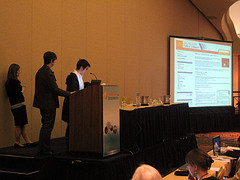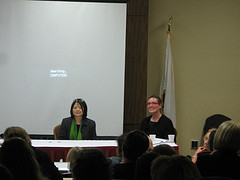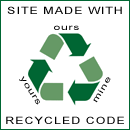March 21st, 2011 Brian Herzog
 Stacy Bruss & Nancy Allmang, Reference Librarians, NIST
Stacy Bruss & Nancy Allmang, Reference Librarians, NIST
To help publicize the library and our services, we decided to create podcasts and dynamic presentations.
Creating Podcasts
Our first attempt was an audio podcast, with a voiceover reading a script using rotating images to provide a visual, saved in mpg4 format. Had trouble finding license-free music on a PC (Mac has Garageband, which has usage music installed). We used Sourceforge, but found that audio podcasts are okay, but people prefer video.
Next, we decided to go with video podcast.
We went with a video production company, but it ended up costing $5,000 and took 7 months. Plus, it didn't end up being a nice, short, informative podcasts - the production company ended up making it long, dry, and boring.
So NIST bought their own camera, microphone, and Macbook. They also built a camera dolly out of a bookcart so the picture was steady. NIST librarians took a free class at an Apple Store to find out how to do it, and then did it.
Tips for creating video podcasts
- it's easiest to do audio voiceovers later, so focus on filming video
- instersperse still images to make it interesting
- limit videos to about 1 minute
- save in two formats: .mov streaming, .mp4 for downloading
Creating Dynamic Presentations
PPTplex - plugin for powerpoint 2007/10 to allow "zooming presentations" - allows you to easily create moving and dynamic presentations, and repeat words and images without making it look like you're repeating yourself. Another tool for zooming presentations is Prezi.com
Ways to use digital presentations
- Use this to make static presentations dynamic
- Conference posters online - make them static and text-heavy, and people with interest will read them
- Digital display - LCD display uses graphics and colors and attracts more attention, so much better than an LED board
- Use video in new employee orientation - videos can show more than pictures or words can convey
Optimal length to display a slide is 7 seconds - that is how long it takes for someone to walk by the NIST display. Time yours so it flips during someone's walk-by, so they see that it changes.
NIST staff researched available displays, and chose one that would support PowerPoint, so staff didn't have to learn new proprietary software
Ideas for the future
Integrating looping video (showing a screencast on how to do something, because people understand how to follow a mouse, and don't require sound)
Marketing the same information using all your marketing channel - not every patron is exposed to every channel This allows you to repurpose your content.
You should also repeat marketing messages, because people forget
Another fun way to make video presentations is using Xtra Normal - all you do is type a script, and it creates the video for you - it's attention-grabbing because it's fun, and makes the information more noticeable (it's easy and fun)
Posted under Uncategorized | Comments Off on CIL2011: Innovative Marketing Tools and Strategies
March 21st, 2011 Brian Herzog
 Laura Solomon, Ohio Public Library Information Network (OPLIN)
Laura Solomon, Ohio Public Library Information Network (OPLIN)
Alexandra Zealand, Social Media Coordinator & News Blog Editor;
Stacia Aho, Library Webmaster;
Jonathan Newton, Library Web Programmer, Arlington Public Library
Don't waste your homepage - Laura Solomon
The library homepage is the most important part of your website - here are some tips for the best use of the space
- Spell it out - patrons don't know library acronyms and jargon. Spell it out, at least the first time you use it
- Don't be wordy, or use large blocks of text
- Mission statements are important to libraries and trustees, but not to patrons, so don't put it on your homepage (nor lists of staff or board names)
- Weed your graphics - graphic loads take time and slow things down and clutter up pages - they need to be meaningful and have a point. And anything you do use, optimize for web
- Don't use clipart - it undermines your professionalism (even using stock photography is better)
- Be careful about using widgets and gadgets - people don't come to the library website to check the weather or news feeds
- Don't use exclamation points!!! They are not professional!!1!
- Your homepage above the fold is your prime real estate - don't cover it with a welcome mat (if they weren't welcome, it would be password protected)
- Don't put a picture of your library on the homepage - your building is not your product
- Put your library's phone number and address on your homepage
- Label all the links to pdf as [pdf] - don't surprise people with huge downloads
Community Engagement on a Shoestring - Arlington VA Public Library
Case study of how they went from municipal website to library-specific website with integrated content to focus on patron needs and use:
- First, convince county IT department to let library have a branded header with its own logo
- Use links on homepage to direct people to library's blog, which looks like real website but is easier to update and control - this keeps the homepage and makes it useful
- Important static information stays on the static site, in case blogger blog went away
- Content on blog is basically news and events - things that would have been press releases
Tools used were all free
- Blogger - easy to use (got for less tech-savvy staff), supports tags, and supports...
- Yahoo Pipes to create news feeds based on tags - use tags to filter information for each branch, so branches can have their own identity and patrons fell more connected with hyper-local information - feeds sometimes get picked up by local news outlets, which drives a ton of traffic, and some people become regular readers
- Feedburner to embed feeds into homepage
- But keep in mind: the tools aren't always enough - you need good practice, staff, content, and integration
Result
- Huge increase in comments and patron participation
- Staff better understands patrons' point of view
- More staff involvement and investment in public image
Posted under Uncategorized | 2 Comments »
March 21st, 2011 Brian Herzog
 Amanda Etches-Johnson, Head, Discovery & User Access, Univ. of Guelph
Amanda Etches-Johnson, Head, Discovery & User Access, Univ. of Guelph
Aaron Schmidt, Consultant, Influx Library User Experience
Two areas of websites we don't have easy control over
Websites must be three things:
Useful
Our Content Strategy (planning the creation, deliver and conveyance of UUD content) must address this question: What do people want to do on our site?
- Identify your critical tasks
- Spend a few minutes each day just asking people what they want to do, and whether or not you're meeting their needs
- Perform a content audit - not just pages, but the images and information on each page (cataloger, being detailed oriented, are good at this). Is each page: accurate, usefulness, used, web-written, on message, last updated. Rate each piece on a scale of 0-2 to identify areas to keep, remove or improve.
Usable
- Smaller is better
- Websites should not be junk drawers - "just in case" is not the right approach
- Design your website around your FAQs - if it's on an FAQ, it doesn't get on the site
- Write for the Web - we keep hearing that people generally don't read on the web (though this might be changing with tablets and larger mobile devices). What people do is Function Reading - skim to find what's important to them
- Write with a conversation and friendly tone, not like a policy document
- Put the most important stuff at the top of the page
- Use bolded headlines, bullets, and white space - it is easier to scan - be sure to use white space correctly to group related headlines/content
- Use simple urls: http://library.org/kids vs. http://library.org/kids/pages/content.php?p=423
- One idea per sentence (fragments okay), not too big, bot too small, never all-caps, use active voice, correct contrast
- Refer to library as "we" and patrons as "you" or "I" - good example "How do I reset my PIN?"
- Never use "click here" - make the link text meaningful ("Search Catalog" instead of "Click here to search the catalog")
- Do usability testing - You can find this out by simply watching people use the website - walk out, ask a patron if they have a minute, give them a task ("use our website to find a receipe" or "can you find out our branch's Tuesday closing time on Tuesday") and then watch them
- Use Google Optimizer to test multiple versions of pages with the same content, to see what content is important and which design works best
It's also important to have a mobile version of your website. Visit Influx.us/onepage - a library website template that puts this idea into practice - works on mobile devices
Desirable
- Choose a good color palette - use a professional, use a free website color matcher, etc
- Don't use clipart
- Use common conventions, grid layout, pre-made themes from the community
- Make content interesting - example: transmissions between NASA control and space flights presented in back-and-forth Twitter-like conversation
- Make it convenient - definitely a mobile-friendly version
- Marketing: put your stuff out there, and keep at it
Four Stages of Library Website Development
One builds on the other, and you can't move up until you finish the lower levels (like Maslov's Hierarchy)
Basic
Necessary information, relevant functionality, no major usability issues
Destination (a "destination website")
Librarian-created content, basic interactivity
Participatory
Serious user generated content, patrons creating culture - library acts as the aggregator, and patrons have reason to do this here, instead of somewhere else
example: Hennapin County bookspace
Community Portal
Library website as community platform, the website becomes a community knowledge bank (tool like this is Kete)
Take-away goal
Reduce your site by half - it doesn't mean you have bad content, but people cant find it because there is too much to look through - bit.ly/smallsites
Tags: aaron schmidt, amanda etches-johnson, cil11, cil2011, computers in libraries, conference, Conferences, librarian, Library, presentation, user experience, ux, web design
Posted under Uncategorized | 3 Comments »
October 19th, 2010 Brian Herzog
 Session notes from a great NELA2010 interactive discussion on reference and where it's headed:
Session notes from a great NELA2010 interactive discussion on reference and where it's headed:
A panel of experienced reference librarians explores the ever-changing landscape of reference service, with particular emphasis on implementing new and emerging technologies. Panelists include Laura Kohl from Bryant University in Smithfield, RI, Eleanor Sathan from Memorial Hall Library in Andover, MA, and Pingsheng Chen from Worcester (MA) Public Library.
Laura Kohl - What Bryant University is Doing
- Offer text (using a Droid rather than online), email, IM
- Goal has been to differentiate librarians from Google and add value "Librarians: the thinking search engine"
- Bryant's mission is to be high-touch and hands-on - they don't just offer access, they provide instruction to make sure people know how to use things
- All reference desks computers are dual monitor/keyboard (one faces staff, one faces patron), so it's easy for students to participate in the search, rather than just watch
- Use Jing to create on-the-fly instructional screencasts for chat and email reference questions. These are uploaded to Jing's server, which archives them for reuse
How to patrons know what is available? Marketing all over the place.
- Word of mouth - go into classrooms, tell people it's okay to interrupt us"
- Hang up tear-off sheets all around campus (including in the bathrooms)
- Have imprinted scrap paper at the desk with library contact information at the bottom
- Use Moo Cards for business cards to hand out. Also used clear labels to add more contact information to the back of the standard business cards
- On Twitter, Facebook (include redundant links to everything, which helps when regular website is unavailable), integrate into Blackboard
- Use digital signage using rotating powerpoints, images, or anything else - these are in the library and throughout campus
- QR codes on signs to go to websites or download contact information into students' smart phones
How to measure success?
- Qualitative - comments from students (email, texts, etc)
- Quantitative - track stats (face-to-face, phone, text, email, IM) - face-to-face is going down but students staying longer, and IMs are way up
Pingsheng Chen - What Worcester Library is Doing
Worcester is 3rd largest city in New England (behind Boston and Providence)
Trend 1: People need a librarian more than every
- Across the country, library use is going up
- Nature of questions have changed - fewer questions that can be handled in the traditional way, and knowing the collection is no longer enough
Trend 2: Reference librarians are reinventing themselves to make a wide range of new reference services available to meet users' current expectations
- Provide learning opportunities for users, especially for job seekers (computer books, job search/resume help, workshops)
- Provide personal assistance for job seekers or others (consult with a librarian, resume/cover letter help, set up LinkedIn or email account)
- Provide virtual reference services - email, chat (QuestionPoint), text (My Info Quest), ebooks and databases for online 24x7 reference (and build Gale bookshelf)
- Use web 2.0 and social networking tools to provide help in more than one way and in more than one place - blog, wiki, delicious links, Bookletters, Facebook, Twitter, MySpace (do them all, because patrons have their own preferences)
Trend 3: Reference services have a bright but challenging future. So, with less money and less staff, we must...
- provide public and free access to ideas and information
- stay current with new technologies and new resources and be able to teach users those information tools and skills
- offer a wide range of reference services to meet users where they are and connect people to information that matters in their lives
- Bottom line: meet users' current expectations (it's about their experience)
Tags: conference, Conferences, Laura Kohl, libraries, Library, nela, nela10, nela2010, new england library association, Pingsheng Chen, presentation, reference, screen, table, talk, trends
Posted under Uncategorized | 3 Comments »
 Stacy Bruss & Nancy Allmang, Reference Librarians, NIST
Stacy Bruss & Nancy Allmang, Reference Librarians, NIST
 Amanda Etches-Johnson, Head, Discovery & User Access,
Amanda Etches-Johnson, Head, Discovery & User Access, 
